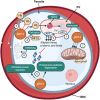Quest for malaria management using natural remedies
- PMID: 39011507
- PMCID: PMC11247327
- DOI: 10.3389/fphar.2024.1359890
Quest for malaria management using natural remedies
Abstract
Malaria, transmitted through the bite of a Plasmodium-infected Anopheles mosquito, remains a significant global health concern. This review examines the complex life cycle of Plasmodium, emphasizing the role of humans and mosquitoes in its transmission and proliferation. Malarial parasites are transmitted as sporozoites to the human body by biting an infected female Anopheles mosquito. These sporozoites then invade liver cells, multiply, and release merozoites, which infect red blood cells, perpetuating the cycle. As this cycle continues, the affected person starts experiencing the clinical symptoms of the disease. The current treatments for malaria, including chloroquine, artemisinin-based combination therapy, and quinine, are discussed alongside the challenges of drug resistance and misdiagnosis. Although efforts have been made to develop a malarial vaccine, they have so far been unsuccessful. Additionally, the review explores the potential of medicinal plants as remedies for malaria, highlighting the efficacy of compounds derived from Artemisia annua, Cinchona species, and Helianthus annuus L., as well as exploration of plants and phytocompounds like cryptolepine, and isoliquiritigenin against drug-resistant Plasmodium species. Moreover, studies from Pakistan further highlight the diverse vegetal resources utilized in malaria treatment, emphasizing the need for further research into natural remedies. Despite the advantages of herbal medicines, including cost-effectiveness, and fewer side effects; their limitations must be taken into account, including variations in potency and potential drug interactions. The review concludes by advocating for a balanced approach to malaria treatment and prevention, emphasizing the importance of early detection, accurate diagnosis, and integrated efforts to combat the disease in the endemic regions.
Keywords: Artemisia; Cinchona; drug resistance; malaria; natural products.
Copyright © 2024 Ain, Saleem, Munawar, Nawaz, Naseer and Ahmed.
Conflict of interest statement
The authors declare that the research was conducted in the absence of any commercial or financial relationships that could be construed as a potential conflict of interest.
Figures





Similar articles
-
Folic acid supplementation and malaria susceptibility and severity among people taking antifolate antimalarial drugs in endemic areas.Cochrane Database Syst Rev. 2022 Feb 1;2(2022):CD014217. doi: 10.1002/14651858.CD014217. Cochrane Database Syst Rev. 2022. PMID: 36321557 Free PMC article.
-
Natural products as starting points for future anti-malarial therapies: going back to our roots?Malar J. 2011 Mar 15;10 Suppl 1(Suppl 1):S3. doi: 10.1186/1475-2875-10-S1-S3. Malar J. 2011. PMID: 21411014 Free PMC article. Review.
-
Medicinal plants used in the treatment of Malaria: A key emphasis to Artemisia, Cinchona, Cryptolepis, and Tabebuia genera.Phytother Res. 2020 Jul;34(7):1556-1569. doi: 10.1002/ptr.6628. Epub 2020 Feb 5. Phytother Res. 2020. PMID: 32022345 Review.
-
Amazonian plant natural products: perspectives for discovery of new antimalarial drug leads.Molecules. 2013 Aug 2;18(8):9219-40. doi: 10.3390/molecules18089219. Molecules. 2013. PMID: 23917112 Free PMC article. Review.
-
Effects of the antimalarial drugs ferroquine and artesunate on Plasmodium yoelii yoelii gametocytegenesis and vectorial transmission.Sante. 2011 Jul-Sep;21(3):133-42. doi: 10.1684/san.2011.0261. Sante. 2011. PMID: 22294247
References
-
- Adedeji W. A., Balogun T., Fehintola F. A., Morse G. D. (2018). Drug-drug interactions of antimalarial drugs. Drug Interact. Infect. Dis. Antimicrob. Drug Interact., 503–514. 10.1007/978-3-319-72416-4_12 - DOI
-
- Afzal H. S., Khan W., Nawaz S., Malik Utra A., Ahmad T. (2022). Investigation of the diuretic potential of diosmetin, a flavonoid from citrus lemon in sprague-dawley rat model. Phytopharm. Commun. 2 (02), 115–126. 10.55627/ppc.002.02.0151 - DOI
Publication types
Grants and funding
LinkOut - more resources
Full Text Sources
Research Materials

